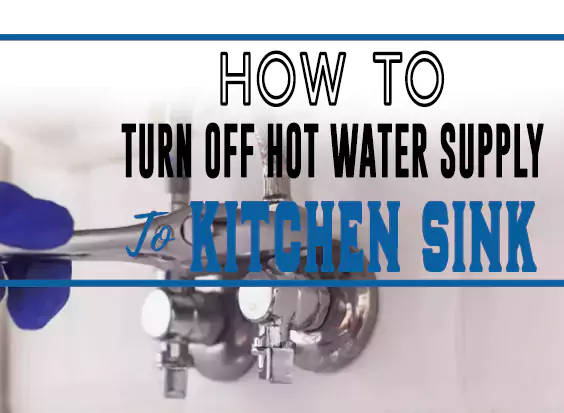Turning off the hot water supply is a common step for plumbing jobs, as you can’t replace any part that’s connected to the pipelines while water flowing through them.
You need to shut off the water supply for plumbing repairs. Here’s how to turn off hot water supply to kitchen sink with our full guide.
The hot water supply is usually the plumbing system that needs stopping. Hot water system installation, maintenance, and similar jobs will require turning off the hot water supply.
In this post, I’ll explain how to turn off the hot water supply to the kitchen sink. I’ll also talk about what to do if you’re dealing with damaged or no valves.
How to Turn Off Hot Water Supply to Kitchen Sink

Most modern kitchen sinks have similar mechanisms, so following these easy steps shouldn’t be an issue. The best thing is, you don’t need any tools for this operation.
Step 1: Locate the shutoff valves
A shutoff valve is a common part of your sink or faucet that controls the main water supply. It’s also known as an isolation valve as it isolates your sink or faucet water supply from the mains. That way, you can repair or replace the respective parts without worrying about overflows.
You can increase or decrease the maximum allowed water speed through your faucet with it, but you can also turn off the water supply completely.
You’ll usually find the shutoff valves under the sink, on the piping section. It’s usually hidden inside the cupboard or behind the cover, but it can be in the open too. You’ll see one or two knobs on the pipes. Those are the shutoff valves.
Usually, the modern valves are of stopcock type. These are used in laundry rooms, kitchen sinks, bathrooms, and places where you don’t need to deal with high-pressure flows. Stopcocks sit on the pipeline, come with washers, and control the flow under normal conditions.
Another type of valve is the gate valve. You may find them in older kitchen faucet systems. They’re usually situated at the mains. They’re more rigid and can be used for high water pressure scenarios. But for both of these valves, the process is similar. The valve can be a lever or knob.
Step 2: Find the hot water valve
There are usually two shutoff valves for turning off the kitchen water supply if you have a mixed system. These are for hot and cold water. You can identify the valves with their respective colors. A hot water supply contains a red valve, whereas a cold water supply has a blue valve.
Sometimes only one valve is colored and the other is transparent or white. But the color will still include either red or blue on their caps. If you turn off both the valves, the water supply to the faucet will disconnect completely. So, you need to find and shut the hot water valve off.
Step 3: Shut the hot water valve off
Now that you’ve found the hot water valve, you can turn it off. It’ll shut the hot water supply only, but the cold water will still be on. Gently rotate the valve to turn it off. Knobs and levers rotate clockwise to turn off.
If you have screws instead of knobs, there are different approaches. Some shutoff valves might contain screws instead of knobs or levers. You need to rotate the screw at a distance of half circle.
To do that, you can always use a flat head screwdriver. Insert the screwdriver into the screw of your hot water valve and gently rotate the screw halfway. You’ll find that it stops the hot water supply. If you need to stop the cold supply too, turn it off the same way with a half turn.
Step 4: Check the water supply
After turning off the shutoff valve for the hot water supply only, it’s time to check. Turn on your faucet to check if the water flow is cold or not. It’ll also remove the residue of hot water in the pipeline.
You should find out that the water flow is cold. If so, the process of turning off hot water supply to kitchen sink. Now you can do repair works on your hot water systems or take part in energy saving during the summer season.
These steps are similar to the default methods and mechanisms modern faucets use. If your faucet has mixed flow with both hot and cold supply, the valves will be distinguishable by their colors.
However, sometimes you may not have any valve on your sink. Sometimes the valves may get stuck due to long-term exposure to a corrosive environment. There are various ways you can troubleshoot these issues, as we’ll see in the next sections.
How to Shut off Water Supply Sink with No Valve
Step 1: Shut off the mains
Find the main shutoff valves that distribute the water to the whole house. You can shut this main valve in the similar way mentioned before. It’s a single valve that, when turned off, shuts off all sinks and bathroom water supplies. As long as you’re not done and turn it on, you can’t use tap water.
Step 2: Shut off water meter
Many houses don’t have mains installed. In those cases, you can directly shut off the water meter. Water meters are usually in the basements.
If you don’t have that, you can go in front of your house and find the meter pit. This contains a curb stop that faces the roadside. Turn it off and the water supply to the home shuts off.
Step 3: Shut off using dry ice temporarily
This is a risky process that should be done only when no other method worked. You need to have a spare valve with you. Take some dry ice and pack it around the pipe over the cabinet. This’ll freeze the water supply.
Check if the water is shut off with ice, then insert the valve quickly. Break the ice from outside by hitting the pipe gently. In this way, you can shut off the sink.
How to Turn off Water when the Valve Stuck
Valves can get stuck in various ways from the corrosive environment, thread damages, or low-quality material. You’ll have to free the valve from its stuck position, then you can shut off the water. You need:
- Penetrating oil
- A hairdryer or lighter
- A wrench
Step 1: Apply some penetrating oil
Penetrating oils are cheap and commonly found in shops. Pour a little penetrating oil onto the stuck valve. It’s low on viscosity, so the oil spreads inside any buildup and loosens the valve a bit.
Step 2: Heat up the valve gently
You can use a hairdryer to heat the valve. Heating up will cause a small expansion of the valve. As a result, the valve loosens more. If you need more heat, you can carefully use a lighter or torch to heat it more.
Step 3: Gently rotate the valve
Now that the valve is shut off, gently rotate it clockwise to shut the water supply. You can use a wrench if it’s still hard enough but do so gently. Or, go back to apply more oil and heat the valve more. When the valve is free, you can shut off the kitchen water supply with it.
Final Thoughts
Kitchens use similar setups so the process is quite similar. But for situations where valves are inoperable or it’s impossible to shut off tap at a kitchen sink, you might need to use the latter methods. It’s essential to have the main supply system because it gives you an option to turn off the hot water supply easily.

